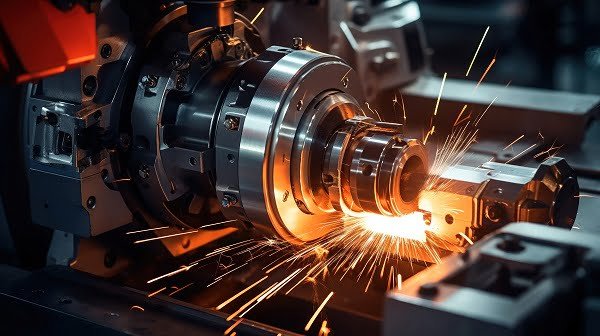CNC (Computer Numerical Control) milling is a process that has revolutionized the manufacturing industry. With its roots tracing back to the 1940s, CNC milling has evolved significantly, becoming a cornerstone in modern manufacturing. This technology allows for the automation of machining tools via precisely programmed computer commands, replacing manual control with speed and accuracy.
Today, CNC milling is crucial in producing complex and high-precision components used in various industries, including aerospace, automotive, and medical devices.
The Basics of CNC Milling
Understanding CNC milling starts with recognizing the machinery and technology involved. CNC milling machines come in various configurations, most commonly distinguished by their axes: 3-axis, 4-axis, and 5-axis machines.
- 3-Axis Milling: This is the most basic form of CNC milling, involving three linear motion axes (X, Y, and Z). It is ideal for simple milling tasks but limited in complexity.
- 5-Axis Milling: These machines add two rotational axes to the three linear axes, allowing for the machining of more intricate and complex parts. This capability is particularly valuable in industries that require high precision and complex geometries.
At the heart of these machines are powerful motors, sophisticated controllers, and robust frameworks that ensure stability and precision. Additionally, modern CNC milling machines are equipped with advanced software that enhances their capabilities and efficiency.
From Idea to Design
The CNC milling process begins long before any material is cut. It all starts with an idea, which is then transformed into a detailed design using CAD (Computer-Aided Design) software. CAD software allows engineers and designers to create precise 2D or 3D models of the parts they wish to manufacture.
Once the design is complete, it is transferred to CAM (Computer-Aided Manufacturing) software. CAM software converts the CAD model into a series of instructions that the CNC milling machine can follow. This process involves selecting the appropriate tools, defining tool paths, and setting parameters such as cutting speed and feed rate.
Material Matters
One of the strengths of CNC milling is its versatility in terms of materials. A wide range of materials can be processed, each offering unique properties and benefits:
- Metals: Common metals include aluminum, steel, titanium, and brass. Metals are prized for their strength, durability, and resistance to wear and corrosion.
- Plastics: Materials like ABS, polycarbonate, and nylon are frequently used in CNC milling due to their lightweight and versatile properties.
- Composites: Advanced composites, such as carbon fiber and fiberglass, offer high strength-to-weight ratios and are used in industries like aerospace and automotive.
Choosing the right material for a specific application is crucial, as it directly impacts the performance and longevity of the final product.
The Milling Process
The journey from design to reality involves several key steps in the CNC milling process:
- Setup: The operator loads the material onto the machine’s worktable and secures it using clamps or fixtures. The cutting tools are also installed and calibrated.
- Programming: The CAM-generated instructions are loaded into the CNC machine’s controller. This program dictates the movement and operation of the machine.
- Machining: The CNC milling machine begins cutting the material according to the programmed instructions. The cutting tools remove material in a controlled manner, shaping the part to match the design specifications.
- Finishing: Once the initial machining is complete, secondary processes such as deburring, sanding, and polishing may be carried out to achieve the desired surface finish and tolerances.
- Inspection: The final part is inspected for quality and accuracy. Advanced measurement tools, such as coordinate measuring machines (CMM), ensure that the part meets all specifications.
Quality Control
In CNC milling, precision is paramount. Errors in machining can lead to costly scrap, rework, and delays. To ensure the highest level of accuracy, several quality control measures are implemented:
- Tool Calibration: Regular calibration of cutting tools and machine components ensures consistent performance.
- Simulation and Testing: CAM software often includes simulation features that allow operators to test the machining process virtually before actual cutting begins.
- In-Process Monitoring: Sensors and monitoring systems can detect anomalies during machining, allowing for real-time adjustments.
- Post-Process Inspection: Advanced measurement tools verify the dimensions and tolerances of the final part, ensuring it meets all quality standards.
Applications of CNC Milling
CNC milling is employed in a wide range of industries and applications, thanks to its versatility and precision:
- Aerospace: Manufacturing complex components such as turbine blades, structural parts, and prototypes.
- Automotive: Producing engine parts, transmission components, and custom prototypes.
- Medical Devices: Creating intricate surgical instruments, implants, and prosthetics with high precision.
- Electronics: Fabricating enclosures, connectors, and intricate circuit board components.
- Consumer Goods: Customizing and prototyping products ranging from household items to sporting equipment.
The Future of CNC Milling
As technology continues to advance, so does the field of CNC milling. Emerging trends and innovations are poised to shape the future of this industry:
- Automation and AI: Increased automation and the integration of AI will streamline processes, reduce human error, and enhance productivity.
- Additive and Hybrid Manufacturing: Combining CNC milling with additive manufacturing (3D printing) will enable the creation of more complex and customized parts.
- Improved Materials: Advances in material science will introduce new materials with enhanced properties, expanding the possibilities for CNC milling.
- IoT and Connectivity: The Internet of Things (IoT) will enable better machine-to-machine communication and real-time data analysis, optimizing production processes.
Conclusion
CNC milling is a powerful and versatile technology that has transformed modern manufacturing. From the initial design to the final product, the CNC milling process offers precision, efficiency, and quality control. Whether you’re in aerospace, automotive, medical devices, or any other industry, CNC milling can turn your designs into reality with unparalleled accuracy.
Are you ready to take your designs from concept to reality? Join us on this exciting journey and explore the endless possibilities of CNC milling.
